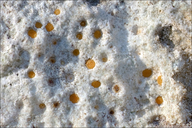|
|
click photo for larger file

Protoblastenia incrustans
|
Photographer: Dr. Amadej Trnkoczy
ID: 0000 0000 0318 0006 (2018-03-01)Copyright © 2018 Dr. Amadej Trnkoczy
|
|
INFORMATION PROVIDED WITH THE PHOTO
|
date of photo Feb 10, 2018
latitude 46.36017 longitude 13.70411
View on Google Maps.
location
Lower Trenta valley; between villages Soča and Trenta; right bank of river Soča; next to the path from Trenta 2 farmhouse (now holiday cottage) to Trenta 2B cottage, East Julian Alps (Posočje, Slovenia)notes Slo.: ? - syn.: Callopisma rupestre f. incrustans (DC.) Walt. Watson, Caloplaca incrustans (DC.) Flagey, Lecanora incrustans (DC.) Ach., Lecidea incrustans (DC.) Chevall., Lecidea incrustans (DC.) Chevall. - Habitat: man made stone wall delimiting former pastures now partly overgrown with bushes and trees; slightly inclined mountain slope, southeast aspect; calcareous ground; partly in shade; relatively dry and warm place; partly protected from direct rain by tree canopies; average precipitations ~ 3.000 mm/year, average temperature 7-9 deg C, elevations 580 m (1.900 feet), alpine phytogeographical region. - Substratum: +/- vertical hard calcareous rock surface. - Comment: Genus Protoblastenia is comprised by lichens living on rock (saxicolous). Their thallus is crustose or grows within solid rock (endolithic) or it is something in between these two options. These lichens have usually yellow, orange or red apothecia and simple cell spores (Ref.:3). Their similarity to Caloplaca species on macroscopic level causes frequent confusions. However, Caloplaca species have two celled spores (septate spores), which distinguish them from Protoblastenia species with certainty. - Protoblastenia incrustans is a common lichen, but it is certainly many times overlooked. Namely, thallus is usually endolithic and consequently hard to be seen. Its apothecia are very small, from only 200 to 500 microns in diameter (Ref.:3) and can also hardly be seen by naked eye in spite of the fact that they are bright yellow-orange color. Characteristically, its apothecia sit in small pits in the rock. Their surface is from slightly concave to slightly convex shape, most of them are nearly flat. This species is an arctic-alpine element (Ref.:5). - Ref.: (1) F.S. Dobson, Lichens, The Richmonds Publishing Ca.LTD (2005), p 364. (2) http://www.dorsetnature.co.uk/pages-lichen/lch-387.html (accessed 28.2.2018) (3) C.W.Smith, et all, The lichens of Great Britain and Ireland,The British Lichen Society,(2009), p 750. (4) V. Wirth, Die Flechten Baden-Württembergs, Teil. 2., Ulmer (1995), p 773. (5) I.M. Brodo, S.D. Sharnoff, S.Sharnoff, Lichens of North America, Yale Uni. Press (2001), p 586.camera Nikon D700 / Nikkor Micro 105mm/f2.8
contributor's ID # Bot_1111/2018_DSC0841 photo category: Fungi - lichen
|
MORE INFORMATION ABOUT THIS FUNGUS
|
| View all photos in CalPhotos of Protoblastenia incrustans Check Google Images for Protoblastenia incrustans |
|
The photographer's identification Protoblastenia incrustans has not been reviewed. Click here to review or comment on the identification. |
|
Using this photo The thumbnail photo (128x192 pixels) on this page may be freely used for personal or academic purposes without prior permission under the Fair Use provisions of US copyright law as long as the photo is clearly credited with © 2018 Dr. Amadej Trnkoczy.
For other uses, or if you have questions, contact Dr. Amadej Trnkoczy amadej.trnkoczy[AT]siol.net. (Replace the [AT] with the @ symbol before sending an email.) |
|
|
